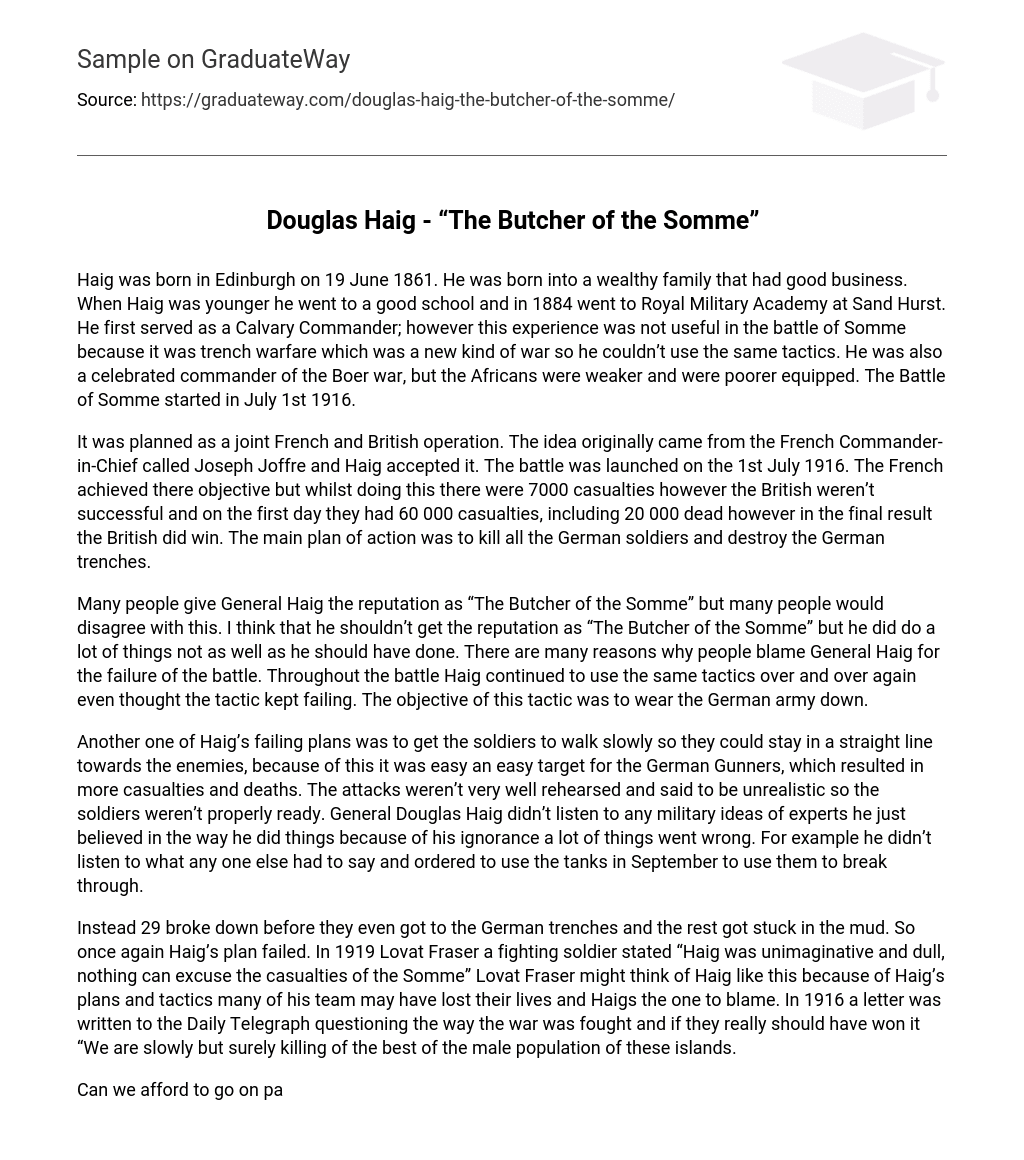Haig, born on June 19th, 1861 in Edinburgh, came from a successful business family. He attended a prestigious school and later joined the Royal Military Academy at Sandhurst in 1884. Initially serving as a Calvary Commander, Haig struggled to adapt his tactics to the trench warfare of the Battle of Somme—a new style of warfare. Despite his previous successes as a commander in the Boer war, Haig faced challenges fighting against weaker African forces. The Battle of Somme began on July 1st, 1916.
Originally intended as a collaborative effort between France and Britain, the concept for the battle was proposed by French Commander-in-Chief Joseph Joffre, which Haig accepted. The battle began on July 1, 1916. While the French accomplished their goal with 7,000 casualties, the British did not fare as favorably and experienced 60,000 casualties in total, including 20,000 fatalities on the initial day. Nonetheless, ultimately the British emerged triumphant. The primary objective was to eradicate all German soldiers and destroy their trenches.
General Haig is often criticized as “The Butcher of the Somme,” but there are differing opinions on this matter. Personally, I do not believe he deserves that reputation, although he did make several errors. There are numerous reasons why General Haig is held accountable for the failures in the battle. He consistently used ineffective tactics throughout the battle with the goal of weakening the German army.
Haig’s plans included getting soldiers to walk slowly in a straight line towards the enemies. However, this made them easy targets for German Gunners, leading to more casualties and deaths. The attacks were poorly rehearsed and unrealistic. Haig ignored military experts and relied on his own beliefs, resulting in numerous failures. He disregarded others’ opinions and ordered the use of tanks in September to break through.
Despite the fact that 29 units broke down before reaching the German trenches and the remaining units became stuck in the mud, Haig’s plan once again proved unsuccessful. In 1919, Lovat Fraser, a soldier who actively fought, described Haig as unimaginative and dull, indicating that the casualties of the Somme cannot be excused. Fraser’s perspective may arise from the belief that many of his comrades lost their lives due to Haig’s tactics and therefore Haig is responsible. In 1916, the Daily Telegraph received a letter questioning the strategies employed during the war, raising doubts about whether victory was truly worth sacrificing “the best of the male population of these islands.”
Can we continue to pay the same price for the same gain? Historians have proposed alternative strategies and tactics that Haig could have employed, such as ceasing the frontal attacks when it became evident that they were ineffective in breaching the German lines. Additionally, there are those who refute the label of “The Butcher of the Somme” and defend Haig against criticisms regarding the high casualty count.
German planes observed the British preparing for an attack, which provided the Germans with fresh concepts for defending their trenches. This cannot be attributed to Haig’s actions. In addition, the Germans had concealed locations unknown to Haig. Thus, when the British bombed the German trenches, the Germans remained safe in deep shelters approximately 12 meters underground. As a result, they managed to surprise General Haig and his soldiers. Trench warfare was a novel form of warfare when General Haig assumed command, and no one else had prior experience in it. Consequently, Haig had to devise innovative approaches that he was unfamiliar with and was unable to employ his conventional techniques.
Although General Douglas Haig used the same tactic more than once, it eventually proved successful. In 1992, Colonel J. H. Boraston lauded Haig’s leadership and commended the effective execution of the Battle of Somme, stating that it was a triumph for the genius of British leadership. Haig strategically employed tanks in the battle to expedite its conclusion and provide protection against machine-gun fire. In conclusion, different individuals have varying opinions on General Douglas Haig and their reasons for such viewpoints differ as well.
I believe he did not deserve the title of “The Butcher of the Somme,” but I do think there were numerous things he should have changed and approached differently. While he ultimately achieved victory with his tactics, the number of casualties exceeded what should have been expected. It is comprehensible why some people associate him with the infamous title, while others disagree. Personally, I find the label “The Butcher of the Somme” to be exaggerated, but it is undeniable that he did not perform as effectively as he could have during the Battle of the Somme.





